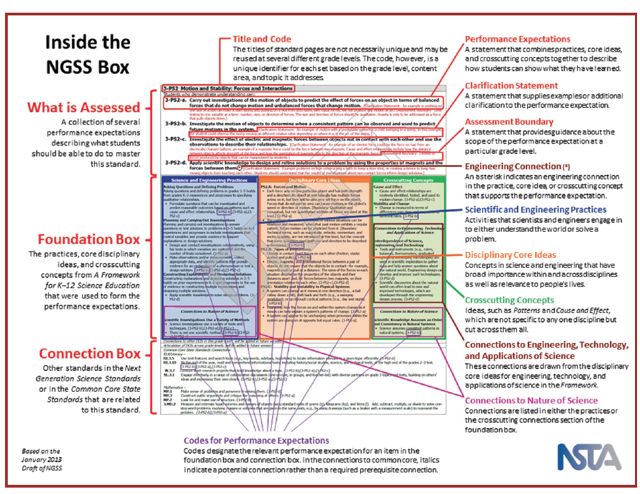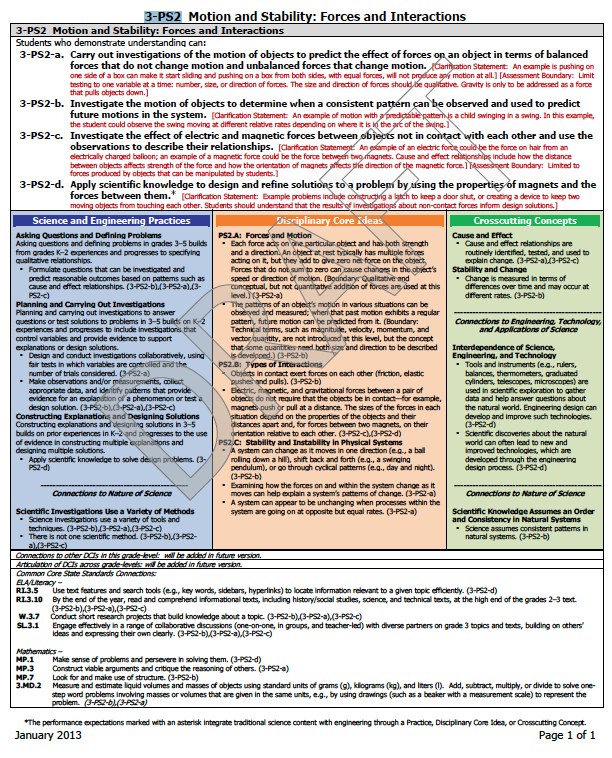Boxed In: How the NGSS Impedes Science Teaching
The major journals of the National Science Teachers Association (NSTA) have published articles featuring and explaining to science teachers the nature of the Next Generation Science Standards (NGSS). The journals include The Science Teacher, Science Scope and Science and Children. For the past several issues, each journal has published articles that deal with different aspects of the NGSS, including what students should know about earth science, life science, and physical science, when they should know it, and why these standards will “help all learners in the nation develop the science and engineering understanding they need to live successful, informed, and productive lives, and that will help them create a sustainable planet for future generations.” (Krajcik 2013, p. ).
These are laudable goals, but the roll out of the NGSS later this year won’t necessarily change or lead to more “productive” lives or help students understand sustainable living or “deep ecology.” The standards do include some environmental and ecology content, but the kind of interdisciplinary thinking that is at the heart of deep ecology simply is not part of the NGSS. In a search of the NGSS draft document, the word ecology does not appear, sustainability was found in only six instances, while 61 instances of the term environmental were found, but most often in the context of environmental impacts or economics. Concepts such as interdependence do occur, but only in relationship to connecting science, engineering and technology. No connection to the biosphere. Then, when the standards that do relate to sustainability are examined, students learn that sustainability is for humans and the biodiversity that supports them. In a deep ecology context, sustainability would refer to all species of living things, and their importance would not be hierarchical.
The rationale for science described in the NGSS is not related to conception or philosophy of a sustainable planet, but is instead science in the service of the economic growth of the nation, job training, and economic competitiveness in a global society. The science standards were designed by scientists and engineers, and so there is a heavy emphasis on scientific process and content instead of thinking about science curriculum that would be in the service of children and adolescents.
Boxed In
In another article in this month’s The Science Teacher, there is a chart that shows the architecture of the Next Generation Science Standards. Think of the chart as a box–a science standards box. Its full of the multiple standard attributes including performance expectations, kind of on-deck behaviors ready to be morphed into assessments. The box is teeming with science & engineering practices, comments about disciplinary core ideas,and cross cutting content, and connections to the nature of science. Symbolically, the box is dense, perhaps so much that one has wonder what is really important. Is this atomistic breakdown of science what will help American education progressives lead schools into a more humanistic world? I don’t know.
Figure 1 shows the same box that appeared in The Science Teacher, but without the explanations of each part of the science box. Notice that there are four sub-boxes, one shaded white (the performance expectations), blue (practices or process of science and engineering), orange (content) and green (connections).
Every set of performance expectations in the NGSS is presented using this box-like structure. The NGSS is 105 pages long on the online pdf draft of the standards. As you scroll through the standards, hundreds of performance expectations are grouped into the content or disciplinary core ideas. The standards will be released this year, and will unfortunately, adopted by most states.
Figure 1. Science Standards Box including performance expectations, processes, content and connections
Let’s take a look at an example of an NGSS Box that appeared in NSTA’s March 2013 edition of The Science Teacher. The NGSS conceptual design is an oversized rectangular box in two dimensions. The box has all the elements that pertain to a grouping of content for 3rd graders in physical science. At first glance theses NGSS boxes make you feel overwhelmed and boxed in. Take a look. First, the standards writers designed the whole shebang by writing the performance expectations in such as way that they can easily be converted to assessments. In this case, this is what every 3rd grader is expected to master for this standard. Below the expectations/assessment box, are 3 foundation boxes which include core disciplinary ideas (orange-earth, life, or physical science), cross cutting concepts (green), and scientific and engineering practices (blue). At the bottom, you will find a connection box which informs science teachers how this standard might be related to the common core, or to state standards. You also find other items tagged on to this complicated scenario including connections to the nature of science, connections to engineering, codes and all of that.

Figure 2. What inside the NGSS Box: Source, NSTA journal, The Science Teacher, March 2013
What’s Next?
In research I’ve reported on here, the standards should be viewed as authoritarian documents that teachers had little to no part in policy decisions. Indeed, in separate research studies reported here, the standards are impediments or barriers to learning not bridges to help children and youth understand their connection to science. In the standards culture, students are pawns in an educational system that is in the interests of the nation’s economy and prosperousness of business and industry.
According to the 2012 Brown Center Report on American Education, the Common Core State Standards will have little to no effect on student achievement. Author Tom Loveless explains that neither the quality or the rigor of state standards is related to state NAEP scores. Loveless suggests that if there was an effect, we would have seen it since all states had standards in 2003.
The researchers concluded that we should not expect much from the Common Core. In an interesting discussion of the implications of their findings, Tom Loveless, the author of the report, cautions us to be careful about not being drawn into thinking that standards represent a kind of system of “weights and measures.” Loveless tells us that standards’ reformers use the word—benchmarks—as a synonym for standards. And he says that they use too often. In science education, we’ve had a long history of using the word benchmarks, and Loveless reminds us that there are not real, or measured benchmarks in any content area. Yet, when you read the standards—common core or science—there is the implication we really know–almost in a measured way–what standards should be met at a particular grade level.
As the Brown report suggests, we should not depend on the common core or the Next Generation Science Standards having any effect on students’ achievement. The report ends with this statement:
The nation will have to look elsewhere for ways to improve its schools.
Teachers will be in a bind when they are told to carry out the new science standards. Wading through the boxes of performance expectations, and foundation components will give any science educator a headache, not to mention the near impossibility of thinking that every student should be exposed to the same set of content goals.
The rationale for the science standards is achievement-based. One way to look at the standards is that they use backwards engineering to define the field of science that teachers should cover in their science courses. A teacher writing on Anthony Cody’s blog explained backward engineered standards. Backward engineering means starting with an assessment, and then working backwards from it to write standards. She explains that “the goal of the Next Generation Science Standards is create a document that can market both teaching and assessment products to a captive education system, not offer a framework for good teaching of science.”
The new standards will not lead on a path that will improve learning. It will however provide documentation for test development companies and consortia to design online assessments that will be used by bureaucrats to foster “data driven” educational reform.
What do you expect will be the affect of the Next Generation Science Standards on science teaching in American schools?
References
Krajcik, Joe (2013). The next generation science standards: A focus on physical science. The Science Teacher, 80 (3), 29 – 35.
This blog post has been shared by permission from the author.
Readers wishing to comment on the content are encouraged to do so via the link to the original post.
Find the original post here:
The views expressed by the blogger are not necessarily those of NEPC.

